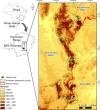Beta diversity of aquatic macroinvertebrate assemblages associated with leaf patches in neotropical montane streams
- PMID: 33815762
- PMCID: PMC8009175
- DOI: 10.1002/ece3.7215
Beta diversity of aquatic macroinvertebrate assemblages associated with leaf patches in neotropical montane streams
Abstract
Over 70% of the total channel length in all river basins is formed by low order streams, many of which originate on mountaintops. Headwater streams play fundamental roles in processing and transporting terrestrial and aquatic organic matter, often harboring high biodiversity in bottom leaf patches deposited from riparian vegetation. The objective of this study was to assess the variation in taxonomic composition (measured by beta diversity of aquatic macroinvertebrates) among stream sites located in the Espinhaço Meridional Mountain Range, part of a UNESCO Biosphere Reserve in eastern Brazil. We tested two hypotheses. (a) Taxa turnover is the main reason for differences in aquatic insect assemblages within stream sites; we predicted that turnover would be higher than nestedness in all stream sites. (b) Stream site altitude and catchment elevation range are the main explanatory variables for the differences in beta diversity; we predicted that local stream site variables would account for only minor amounts of variation. In both dry and wet seasons, we sampled twice in two habitat types (five leaf patches in pools and five in riffles) in each of nine stream sites distributed in three different river basins. We computed average pairwise beta diversity among sampling stations and seasons in each stream site by using Jaccard and Bray-Curtis indices, and calculated the percentages of diversity resulting from turnover and nestedness. Finally, we tested the degree that local- or catchment-level predictor variables explained beta diversity. We found that turnover was the main component of beta diversity and that both dissolved oxygen and elevation range best explained Bray-Curtis beta diversity. These results reinforce the importance of leaf patches in montane (sky islands) Neotropical savanna streams as biodiversity hotbeds for macroinvertebrates, and that both local and landscape variables explained beta diversity.
Keywords: campos rupestres; leaf packs; nestedness; streams; taxa richness; turnover.
© 2021 The Authors. Ecology and Evolution published by John Wiley & Sons Ltd.
Conflict of interest statement
The authors have no conflicts of interest to declare.
Figures



References
-
- Abell, R. , Thieme, M. J. , Revenga, C. , Bryer, M. , Kottelat, M. , Bobutskaya, N. , Coad, B. , Mandrak, N. , Contreras‐Balderas, S. , Bussing, W. , Stiassny, M. L. J. , Skelton, P. , Allen, G. R. , Unmack, P. , Naseka, A. , Ng, R. , Sindorf, N. , Robertson, J. , Armijo, E. , … Petry, P. (2008). Freshwater ecoregions of the world: A new map of biogeographic units for freshwater biodiversity conservation. BioScience, 58, 403–414. 10.1641/B580507 - DOI
-
- Almeida‐Abreu, P. A. A. (1995). O supergrupo Espinhaço da Serra do Espinhaço Meridional (Minas Gerais): O rifte, a bacia e o orógeno. Revista Geonomos, 3, 1–18.
-
- Al‐shami, S. A. , Heino, J. , Che salmah, M. R. , Abu hassan, A. , Suhaila, A. H. , & Madrus, M. R. (2013). Drivers of beta diversity of macroinvertebrate communities in tropical forest streams. Freshwater Biology, 58, 1126–1137. 10.1111/fwb.12113 - DOI
-
- Alvares, C. A. , Stape, J. L. , Sentelhas, P. C. , de Moraes Gonçalves, J. L. , & Sparovek, G. (2013). Köppen's climate classification map for Brazil. Meteorologische Zeitschrift, 22, 711–728. 10.1127/0941-2948/2013/0507 - DOI
-
- Anderson, M. J. (2017). Permutational multivariate analysis of variance (PERMANOVA). In Balakrishnan N., Colton T., Everitt B., Piegorsch W., Ruggeri F. & Teugels J. L. (Eds.). Wiley StatsRef: Statistics reference online (pp. 1–15). London: Wiley. 10.1002/9781118445112.stat07841 - DOI
Associated data
LinkOut - more resources
Full Text Sources
Other Literature Sources

